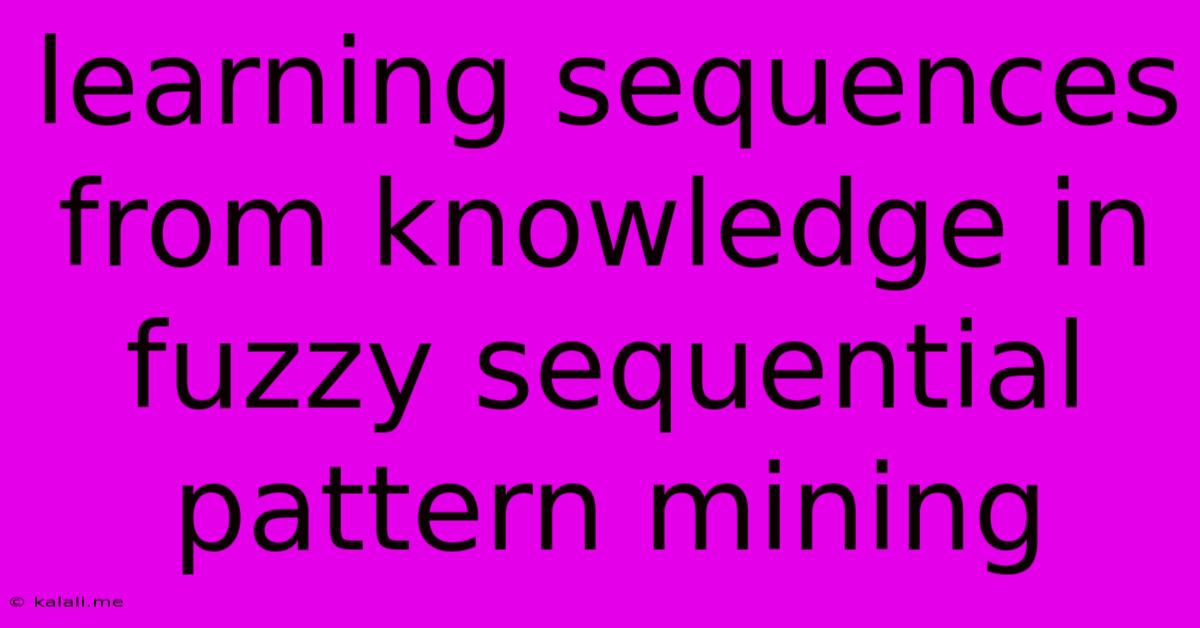Learning Sequences From Knowledge In Fuzzy Sequential Pattern Mining
Kalali
Jun 06, 2025 · 3 min read

Table of Contents
Learning Sequences from Knowledge in Fuzzy Sequential Pattern Mining
Meta Description: This article delves into the fascinating field of fuzzy sequential pattern mining, explaining how to extract meaningful sequences from knowledge bases containing uncertainty and imprecision. We explore techniques for handling fuzzy data and discover effective strategies for learning sequential patterns.
Fuzzy sequential pattern mining presents a unique challenge: uncovering meaningful sequences within datasets characterized by vagueness and ambiguity. Unlike traditional sequential pattern mining, which operates on crisp, clearly defined data, fuzzy mining accounts for the inherent uncertainty present in real-world scenarios. This uncertainty might stem from subjective assessments, imprecise measurements, or incomplete information. This article explores the methodologies involved in extracting knowledge from such datasets.
Understanding the Fuzzy Environment
Before diving into the techniques, it's crucial to understand the fuzzy logic underpinning this approach. Fuzzy logic deals with uncertainty through the use of membership functions. These functions assign a degree of membership (a value between 0 and 1) to an element within a fuzzy set. For instance, instead of simply categorizing an apple as "red" or "not red," a fuzzy set might assign a membership value of 0.8 to "red" and 0.2 to "green," reflecting the nuanced reality of apple color.
This concept extends to sequential data. Instead of having a crisp sequence like <A, B, C>, we might encounter fuzzy sequences where the membership of each element in its respective set is considered. For example, a sequence <A(0.7), B(0.9), C(0.6)> suggests a varying degree of confidence in the presence of each element within the sequence.
Techniques for Fuzzy Sequential Pattern Mining
Several techniques are employed to mine sequential patterns from fuzzy data. These often involve adapting traditional sequential pattern mining algorithms to accommodate fuzzy sets and membership degrees:
-
Fuzzy PrefixSpan: This algorithm extends the popular PrefixSpan algorithm by incorporating fuzzy set representations. It efficiently discovers frequent fuzzy sequential patterns by traversing a projected database, considering the membership degrees during the support calculation. The support threshold, determining the minimum frequency of a pattern, becomes a fuzzy concept itself, potentially leading to more nuanced results.
-
Fuzzy GSP (Generalized Sequential Patterns): Similar to Fuzzy PrefixSpan, adaptations of the GSP algorithm handle fuzzy data by incorporating membership degrees into the pattern frequency calculation. The core concept remains the same: finding frequent sequences, but with fuzzy logic managing the uncertainty within the data.
-
Fuzzy Apriori-based Approaches: Modifications to the Apriori algorithm can also be implemented. These involve adjusting the support and confidence measures to consider fuzzy membership values. The generation of candidate patterns and pruning steps are adjusted to accommodate the fuzzy nature of the data.
Challenges and Considerations
The process isn't without its difficulties. Key challenges include:
-
Defining Fuzzy Sets: Establishing appropriate membership functions requires careful consideration and domain expertise. The choice of membership function significantly influences the resulting patterns.
-
Computational Complexity: Handling fuzzy sets increases computational complexity compared to crisp sequential pattern mining. Efficient algorithms and optimized data structures are essential.
-
Interpreting Results: Interpreting the results requires a good understanding of fuzzy logic and the implications of membership degrees. The meaning of a fuzzy sequence needs careful consideration within its context.
Applications
Fuzzy sequential pattern mining has applications in various fields, including:
- Medical Diagnosis: Analyzing patient medical history with uncertain or imprecise data.
- Financial Forecasting: Identifying patterns in financial time series data with inherent noise and uncertainty.
- Customer Behavior Analysis: Understanding customer purchase sequences with ambiguous or incomplete information.
- Web Usage Mining: Analyzing user website navigation patterns where user actions might have uncertain interpretations.
Conclusion
Fuzzy sequential pattern mining provides a powerful tool for extracting knowledge from datasets containing uncertainty and imprecision. By adapting traditional sequential pattern mining algorithms and leveraging fuzzy logic, researchers can uncover valuable insights from real-world data that would otherwise be lost using traditional crisp approaches. The careful selection of membership functions and thoughtful interpretation of results are crucial for successful application of these techniques. Future research may focus on developing even more efficient and robust algorithms for handling increasingly complex fuzzy sequential data.
Latest Posts
Latest Posts
-
What Is It Called When Someone Sets Up 2 People
Jun 06, 2025
-
Off Grid Shower Gray Water Tank
Jun 06, 2025
-
Hiq Do I Fix Broken Meshes In Blender
Jun 06, 2025
-
What To Do With Old Checks
Jun 06, 2025
-
Lebesgue Measurable Function And Borel Measurable Function
Jun 06, 2025
Related Post
Thank you for visiting our website which covers about Learning Sequences From Knowledge In Fuzzy Sequential Pattern Mining . We hope the information provided has been useful to you. Feel free to contact us if you have any questions or need further assistance. See you next time and don't miss to bookmark.